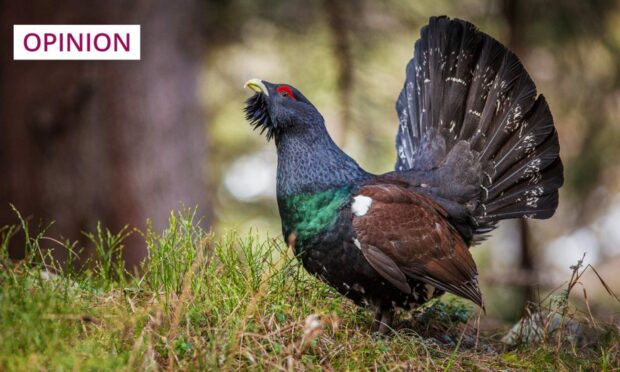Deep in the pine woods of the Cairngorms and northern Scotland, our most iconic species of bird is in rapid, terminal decline.
It is a remarkable sight in winter: the stark contrast of the soft white snow against the capercaillie, the largest of the black grouse in the world, taking the Latin classification name of Tetrao urogallus.
In fact, looking more closely at its scientific name, the male capercaillie is a tad “gallus” in its manner, especially during its rather ostentatious and grand breeding display, known as a “lek”. During the lek, the bird emits distinctive gurgling noises with sporadic cork-popping sounds, a noise synonymous to the forests of the north. Yet, it is rapidly diminishing in frequency every year.

Lamentably, the beautiful red comb on this majestic bird mirrors its precarious conservation status. Placed on red alert, data shows a continued decline in breeding success over time.
When surveys commenced in 1991, capercaillie numbered approximately 2,200 birds, spread from Argyll in the south-west, to Aberdeenshire in the east, and beyond to Ross-shire in the north. Concerningly, recent figures show there are only 542 of the birds estimated to be left in Scotland.
Scottish Government nature policies aren’t good enough
Despite repeated warnings from conservationists that the capercaillie is nearing extinction, the Scottish Government has an antithetical raft of policies on biodiversity and wildlife management.
Put bluntly, there are contradictory objectives running through the government’s current nature policies. For example, in a February NatureScot report, it was highlighted that “reductions in the numbers of predators (foxes, pine martens, crows) would rapidly improve the breeding success of Capercaillie”.
Yet, the recently introduced Hunting with Dogs Bill, which is currently progressing through Holyrood, seeks to limit the number of dogs permitted for effectively controlling fox populations.
Combine this with an existing cluttered landscape of different government strategies, all with competing aims, and are we surprised that the fortunes of the capercaillie are in dire straits?
Give land managers the right tools
A considerable tranche of Scotland’s last remaining capercaillie forests, such as those found in the Cairngorms, are managed by government agencies. They have effectively had no predator control for many years.
Despite decades of public money being ploughed into grand conservation projects through such agencies, we see very little progress. It is no wonder the capercaillie is fighting an uphill battle on home turf.
To slow the decline, land managers must be given the appropriate tools for greater predator control, and we must see a sharper policy focus, allowing local skills, knowledge, and expertise to chart the course of capercaillie survival.
If immediate action is not taken, soon the pine forests may fall silent, with the beautiful capercaillie long gone.
Peter Clark is public affairs manager for the British Association for Shooting and Conservation (BASC) in Scotland



Conversation